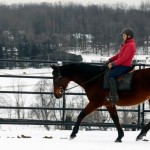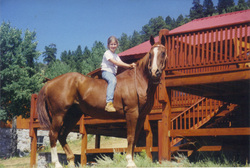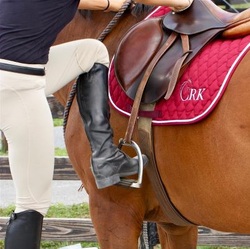We’ve heard the terms “getting ahead” or “left behind” in reference to riding horses, and essentially, being out of balance while riding. But what do these terms really mean and what does it look like when someone is ahead or behind the motion of the horse?
In today’s video, I hope to answer those questions and share a few tips for staying in balance.
When someone is riding ahead of the motion, they are usually leaned slightly forward and are probably pinching tightly with their knees. When behind the motion, a person is typically slouched and has their legs forward, feet pushed against the stirrups.
There are lots of times when we may accidentally get thrown off balance – such as getting left behind over a jump, or there are times we have habits of shifting out balance, such as getting ahead of the motion asking for the canter (likely resulting in a really fast trot). When we can start to notice our habits, they generally become a lot easier to correct.
Take a few minutes to watch the video below then leave a comment identifying a particular habit that you have. My habit? I tend to get a bit behind the motion the last few strides before a jump. I often sit back just a bit too far and can end up driving the horse towards the fence. It’s one of those unconcious habits that I have to stay aware of.
See you in the comments!
Callie















25 Responses
Being fairly new to riding, I didn’t exactly know what these terms were until you explained them. Very helpful. Having seen this now, I think there are times when I may “get ahead” before the canter. Thanks for your help!
Hi Callie!
I have owned horses for about 20 years but because of schedules and raising children I was unable to ride much. I decided recently to take up English riding and started taking lessons. I do not recall ever being concerned when the horse started trotting or cantering but during my first few lessons when my instructor asked me to trot I felt like I had never ridden before. I was definitely “ahead of” the horse for the first I don’t know how many lessons. It’s interesting that you suggested to try purposely getting ahead of and then behind to find the correct balance spot. I think I did that without thinking. Pretty soon I was able to feel when I balanced correctly. I just felt “right” with the horse.
Great video! Thank you.
Diane
Hi Callie,
Great illustrations of what it looks like when a rider is ahead or behind of the motion! Thank-you Callie! I have been told “you are behind the motion” and had ‘not a clue’ what was meant or what it looked like. Now I “see” what it means and understand. I also know that, at the time, I felt like I was putting a lot of pressure on my horse’s mouth,… as if I were balancing off of his mouth which I was. Made a huge difference when I finally figured out (by trial and error) how to balance better (which I still don’t do consistently) unfortunately. My horse really appreciates your videos,…. they help me be a better rider. Cheers,
Corinne
Hi Callie !! I used your info, and immediately felt the difference. I rode too far back and realize the extra pressure I put on the bit, and my legs too far forward. My question is , why do western trainers always tell me to “sit on my pockets” ? It doesn’t feel right and also feels as you described riding behind. What do you think? Thank you for being so clear – I love how you walk it, talk it, and walk it again !
Hi Emma,
Glad it helped! I think the western habit of riding really far back may come for a few reasons – for one, some western saddles are rear balanced, meaning they are designed to put the rider in a more sitting back, legs out front postition. I can’t tell you why they design them in this way, but many are. Second, I believe that many western riding disciplines do require a very deep seat, so the instruction to sit on the pockets is probably for the purpose of finding a deeper seat, which isn’t a bad thing and depending on what you are doing could still keep you in balance with the horse.
I have a tendency to get behind the motion when I am trying to get more speed.. not a great habit. I am sometimes in front when I get a bit tense with a nervous horse – an interesting combination! Love the videos, very helpful. thanks.
Hi Callie
My problem is that I get ahead with my forward transitions so lately in my lessons we have been concentrating on that but now that I’m sitting back more my legs have come forward. When I correct that, my heels are not down, I’m told, so I’m working really hard in all these areas and it can be a little frustrating at times. Your video is great for showing the differences. Thank you.
Hi Sue, It is hard to explain how to position your legs, it is easier if you can find a way to create the feeling for yourself. One way I have found to do this (I learned it from Wendy Murdoch) is to use an exercise band (or she sells Equi-bands) and tie one end to each stirrup then put the band behind your saddle. This creates a v-rigging with the stirrups and helps you feel having your legs back without trying to pull them back. you should feel more of an opening in your hip and down the front of your thigh. Your leg needs to be open at the hip, not just a deep angle at your knee if that makes sense. Hope this helps!
Callie, I would love to see a video on this!
Great suggestion, Shanna!
Hi Callie!
Great video. This explains what I thought you meant, but I hate to assume!
I frequently “get ahead” and then I think I over compensate in my next try and will end up “behind.”
I ride different horses at my lessons. It seems like I find myself more “ahead” on certain horses- does that make sense?
Hi Shanna,
It does make sense – a horse’s way of moving and their conformation can influence how a rider wants to sit. For example, horses with necks attached low tend to encourage the rider to be more forward, while horses with higher neck carriage generally make it easier for the rider to sit back.
Thanks. Gives me a little more confidence. I often wonder if I will ever get this again after taking so many years off.
I think I should probably request to ride the same horse each time so I can find my balance quicker and then maybe I can ride another (but again stick with each horse for awhile). I try to be agreeable so she can place newer riders on the more balanced horses. Maybe I’ll ask for a horse that’s a little off balance and we can work on it together.
I get ahead in the transition to canter. So…one day when my horse, Evie, was a little rambunctious, she ducked her head and shoulder and, you guessed it, I flipped off over said shoulder. Now I work at keeping my seat and hands the same as she picks up the canter. It feels like sitting back in contrast to what I did before but it’s safer and she transitions flatter and quieter.
Added note: I lost my old, retired gelding a few weeks ago. Never knew until now how much he meant to me. RIP Clifford, my big red horse.
So sorry to hear about Clifford, Nancy! I understand how tough it is to lose a friend.
Thanks for this video….very nice
Approx. 8 months ago got back to riding after a 30 year absence.
Your video reminded me of a bad habit that I had approaching jumps, I anticipated
the jump and would almost always ‘ get ahead ‘ ( leaned forward ) of my horses motion.
As I hope to continue riding for as long as possible, I also hope your ‘ reminder ‘ video
stays with me.
Thanks very much Callie
I know I get ahead whenever there is a a stressful situation on the trail I start to clamp with my legs and lean a bit forward. A bad habit which I am now conscious of and trying to break.
I am working on this, but for me, I am definitely behind the motion with my legs farther forward. I continue to work on this and thanks for the video…very helpful to see the difference.
Hi Callie, my instructor makes the comment that I’m always two inches ahead of myself !!! I’m a tipper and tense up in the hands to try to maintain balance. With my new horse who is school-master educated you can imagine the fun with canter transitions he gets confused and cross. Doing lots of work to correct a very old habit…thanks for an insightful video!!!
Glad you enjoyed it Linda!
Great information, good reminder. I ride western, however my horses stop when my legs get too far forward. Really enjoy your blog. Keep up the good work.
Don
Hi Callie, I think this is a great video for new instructors to learn what it looks like to be ahead of and behind the motion, and its potential causes. I’ve shared it on my blog for therapeutic riding instructors at http://www.lessonsintr.com ! Thanks for the great video! -Cindy
Thanks for sharing Cindy!
Thanks Callie, I’ve been binge watching your videos and have found them very helpful. You have a gift for being able to explain complex ideas.
My trainer, a reining trainer, insists I ride behind the motion to drive the horse forward. I am not a reiner, nor do I plan to be, but just want to be able to ride all gaits safely. I am conflicted.